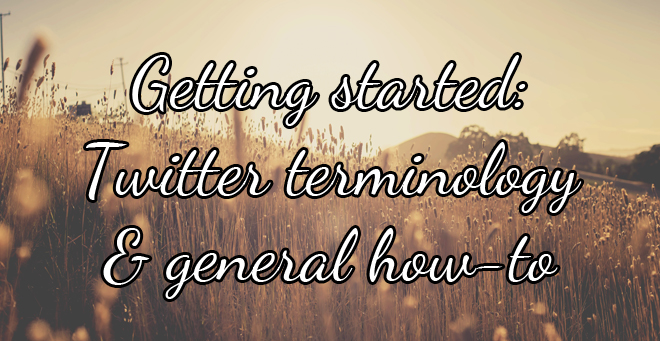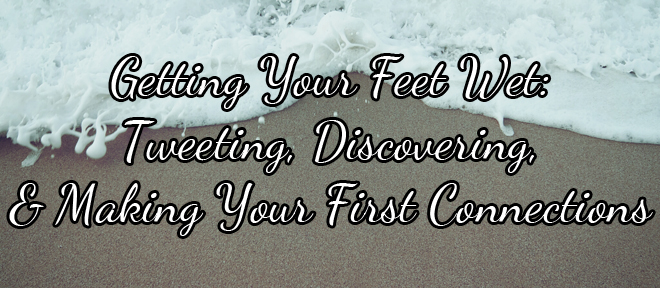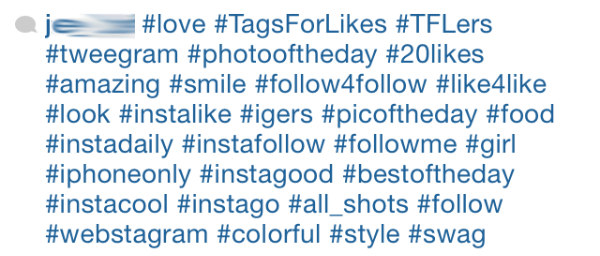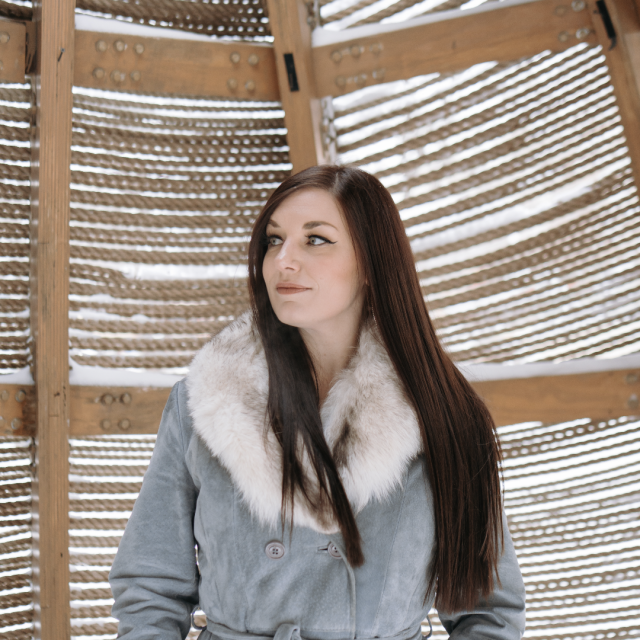Tagged: HowTo
Twitter for Beginners Part 1: Getting Started
- by Alyson Shane
I get asked a lot about my preference of social media platform; namely, which one do I feel is most effective for getting your voice out there and starting to build an audience for yourself.
My favourite, hands down, is Twitter. I love Twitter.
The problem is, I often find that I'm the only one. When I tell people that I love Twitter above all the rest their eyes usually get big and they something like "I don't get Twitter" or "Twitter is too hard!"
So with that in mind, I'm going to be doing a series of Twitter for Beginners posts about this topic: we'll focus not just on how to use this important tool, but also why we should be using it, and best practices for first-time tweeters.

Twitter Terminology
Twitter has a lot of terminology and rules specific to its platform, which is one of the main reasons that so many people steer clear of using it (or don't use it effectively). Here are the basics:
Tweet: a tweet (like the bird logo, get it?) is the body of your message. It can be text, numbers, or characters but it has to remain under 140 characters in total. This is what a lot of people struggle with, because it can be tricky to boil your thoughts down to such a narrow limit.
This, however, is what makes Twitter such a valuable tool. Because you can't ramble on forever and are forced to be concise, the conversations on Twitter flow a lot more quickly and the focus is more on sharing a link to a separate, longer article or thought piece than about making a single statement.
Twitter handle: this is your username on Twitter. It refers to the name that you've chosen and the @symbol that precedes it. For example, mine is @alysonshane.
The @ symbol before your name is how Twitter recognizes that the name or words of your handle are associated with your account.
Mention (@mention): a mention is when you post a public message on Twitter and include someone's Twitter handle in the body of your tweet. When you @mention someone, they receive a notification and (in theory) will begin participating in the discussion.
So if I wanted to tweet at you I would type "hey @yourtwittername, hope you have a great week!" and Twitter would know that because I typed a @ followed by a user name, then I'm tweeting at someone, which is the Twitter equivalent of initiating a conversation with them.
Best practice here is to only @mention people who you know, or who are directly related to what you're tweeting about (eg: article authors, people involved with an event, etc). Tweeting randomly at people is a Twitter faux-pas, and should be avoided (we'll go into more of this later).
Twitter Feed: Your 'feed' is the aggregate of posts from people that you follow, which is displayed on your home page. By paying attention to your feed you can see up-to-date posts in chronological order, which helps you keep track of who said what and when.
ReTweet (RT): A ReTweet is creating a carbon copy of someone else's tweet, which gets shared on your own timeline. This serves as an easy way of sharing links, content, or otherwise showing that you agree with whatever is in the body of the tweet.
Twitter also allows a "Quote" option for ReTweets, which allows you to write your own tweet while including a photo (and link to) the original tweet in your post.
For example, here is a quoted retweet of mine that includes my own comments as well:
Hashtags (#): A hashtag (or # symbol) is a tool for participating in a conversation. A hashtag instantly connects a social media post to a group of others about the same topic, and connects the person sharing it (you) with other people talking about the same topic in real-time.
Brands, companies and individuals all use hashtags as a way of talking to a larger group of people, or of promoting themselves. For example, the sports equipment company Nike frequently includes #justdoit in their tweets. "Just Do It" is Nike's slogan, and helps people understand that what they are sharing is part of a larger narrative.
For more detailed info on hashtags and how to use them, check out my longer, more detailed post on it here.
Direct Message (DM): A Direct Message is a 140 character private message between two people who follow each other.
Most people believe that two people need to be following each other in order to message privately, but there's a feature under Settings > Security & Privacy called "Receive Direct Messages from anyone" which, if selected, allows you to (big surprise) receive messages from any Twitter user even if you don't follow them.
Keep in mind that while still technically "private" a Direct Message can still be saved as a screenshot and shared elsewhere, so be wary of what you DM to your fellow Twitter users. Don't become the next Anthony Weiner!
So we've gone over the basics and you're ready to sign up and start tweeting!
But what do you say?
Who do you say it to?
How do you attract new followers
What can you do to help them find you?
How do you use all of the tools that we've just discussed effectively?
We'll be going over all of that in greater detail in the second installment of this series:

This post is part of the three part series on Twitter for Beginners. Make sure to read part two, part three, and the extra credit as well! The entire series can be found here.
The Power of the Hashtag
- by Alyson Shane
In the last few years the use of the "hashtag" (the # symbol - previously called the 'Pound Sign' if you're a fossil like me and used a push-tone phone growing up) has exploded in popularity. Unless you live under a rock you've likely been bombarded with the hashtag symbol everywhere - on commercials, billboards, on social media, on clothes... these days the "hashtag" is one of the most pervasive and powerful symbols of our digital age.
Despite seeing hashtags everywhere, most people don't understand their importance or how to harness their power to help them convey their message across social media platforms. A simple hashtag can improve your reach, drive brand recognition, and easily engage in large-scale conversations online.

#Why?
If you're a business owner or someone hoping to expand their social media influence, a hashtag should be an important part of your social media strategy. This is because a fitting hashtag can help drive brand recognition, drive customer loyalty, and help spread the word about your idea or product.
A hashtag instantly connects a social media post to a group of others about the same topic, and connects the person sharing it (you) with other people talking about the same topic in real-time.
What this means is that you can include a simple hashtag in your social media post and immediately have it seen by anyone else looking for that hashtag. Here's an example using Twitter:
Above is a tweet that I just created which includes the #SocialMedia hashtag. When I tweet something that includes a hashtag, the hashtag works like a link which allows people to click on it and find other tweets relating to the same subject.
When I click through on the # link Twitter takes me to a page filled with other tweets which include a "#SocialMedia" tag. The "live" feed (people using it in real-time) looks like this:
As we can see, my #SocialMedia hashtag allows me to connect with other people who are tweeting about the same subject, and for others to find my tweet as well. Twitter also offers search options to refine what you want to see from that topic.
Hashtags first started to become commonplace on Twitter as a way to link ideas and conversations in the way that I just described, but other social platforms like Facebook and Instagram have also adopted using them as well.
#How
Even if you know why a hashtag is important, it isn't going to do you much good if you don't know how to use it effectively. In fact, when misused you can actually drive people away from your message because too many hashtags feels spammy (more on that in a second.)
Here's are some ground rules for making sure you're using hashtags to their full usefulness:
- Use the hashtag (#) before relevant words or phrases to categorize posts and help them show up in a search (like in my previous example).
- A hashtag can be included anywhere in the message - they don't have to be stuck at the beginning or at the end if you can work them into the body of your message.
- A hashtag won't appear in a search if your profiles are protected or private.
#Etiquette
Don't #spam #with #hashtags.

(via Google. I have no idea who this poor soul is)
Don't over-tag a single post. Twitter's best practices recommend no more than two per tweet, and in addition to being visually unappealing it also dilutes your message. Using too many hashtags dilutes the meaning of your message because you're trying to appeal to too many ideas at once.
An exception to this rule is Instagram, in which photos with at least eleven (yeah, 11!) hashtags get the most interaction. This is because Instagram doesn't have a character limit for captions on their photos, and because hashtags are the easiest way for its communities to connect with one another
The trick do doing this effectively, however, isn't to include a million hashtags in your original photo post, but rather to include a comment with your wall of hashtags afterward. This ensures that if you're sharing your photo on other social platforms the people seeing it there aren't bombarded with a dozen messy-looking hashtags. That way you're still able to connect with your Insta-communities, but are also saving some face on any other social networks your photos might be sharing to.
What can you do?
Pick a specific hashtag. If you want to start using hashtags to raise awareness for your product, brand or project, pick a specific hashtag and use it exclusively, or with one other hashtag in the body of your post. Make it unique, relevant to what you're talking about and easy to remember.
Start a Twitter Chat. If you're active on Twitter, another great option is to start Twitter chats using a hashtag specific to the theme you want to discuss. These chats operate like live Q&A's on Twitter which are organized around a specific hashtag. For instance, I participate in a Twitter conversation with other Canadian bloggers every week called #blogchatca - the hashtag is easy to include and remember, and allows me to find other people participating in the conversation and respond to them. By including the hashtag #blogchatca I know we're all participating in the same conversation.
Pick something obvious. Make sure that your hashtag is short, easy to remember, and (if possible) unique to whatever you're discussing. For example, this past weekend I participated in a game jam where the official hashtag was #GameJam. This is great because it's easy to remember and find, but it's a pretty widely-used hashtag because many game jams happen at the same time. As a result, many people tweeting about the game jam I attended started using #PegJam to indicate that they were at a game jam in (you guessed it) Winnipeg. This way everyone could find each other easily and see what others were sharing and discussing.
Do you have any tips on hashtag use? Anything you'd avoid doing? I'd love to hear your thoughts!
